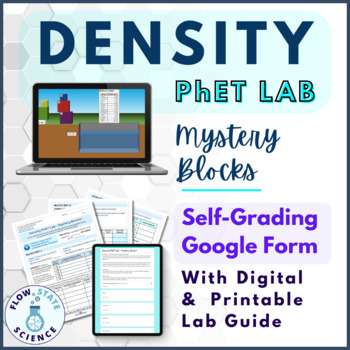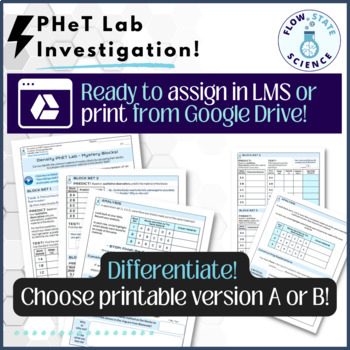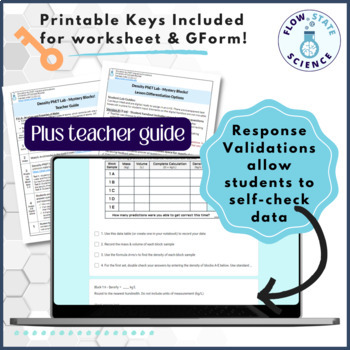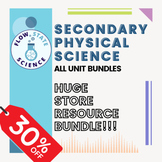Density PhET Lab | Mystery Blocks | Self-Grading Google Form & Virtual Lab Guide
- Google Drive™ folder

What educators are saying
Also included in
- This virtual phet lab duo bundle includes practice for lab procedures, observation, recording qualitative/quantitative data, designing data tables, and critical thinking. Then, concluded with a CER using data from the lab ( with 3 differentiated versions). Grab what you need--one or the DUO bundle fPrice $9.90Original Price $11.00Save $1.10
- This bundle includes all my STORE RESOURCE BUNDLES rolled into one at a 30% discount! Most resources are formatted in Google Drive, are low/no prep, and are ready to print or assign to students in an LMS.This HUGE bundle includes my store resource bundles for the following units and topics:1. Non-coPrice $149.14Original Price $213.05Save $63.91
Description
This is a self-grading, guided virtual lab that explores the relationships of volume, mass, and density using the simulation, Density Lab: Mystery Blocks by PhET! Students are challenged to identify the unknown material of mystery blocks by calculating their density to compare with the known materials in the Density Table. Students follow step-by-step instructions in the google form while tinkering with the simulation, manipulating the variables, making observations, and recording qualitative/quantitative data. Perfect for review on density, data table practice, or as a summative lab.
*This new resource is 50% off until 5/7
Student Lab Guides:
- Are flexible! Can be printed and are digital-ready to assign in an LMS.
- There are transparent text boxes set in place for student input
- Elements on student digital handouts are not movable.
- There are some drag & drop features students can choose to use if completing digitally
Teacher Files Include:
- Teacher guide for differentiated options
- Teacher answer key to lab guide (one answer key applies to both)
- Printable answer key to Google Form. PDF includes clickable links.
- Editable pages so you can modify to your classroom needs :)
⏲ This activity can be +/- 45 minutes, depending on learning levels and the format of lesson delivery.
= = = = = = = = = = ===== = = = = = = = = = = =
✏ Differentiated Options:
= = = = = = = = = = ===== = = = = = = = = = = =
Version A (3 pg) - Student handout includes space for written questions
- The teacher can choose to allow students to complete written questions after submitting the form, reading feedback, and/or class discussion. Then, correcting any misconceptions
- Teaches students independence, self-correction & reflection skills, and taking responsibility for learning
*I do not recommend having students simultaneously type answers to written questions in the form and then copying answers on the handout. This can be daunting to students –with good reason.
Version B (3/2 pg) - Student handout includes data tables.
- Quicker Version - students answer all questions in the form, checking answers & reviewing feedback after submitting.
- Data tables are larger, offering more space
- May choose to omit the last page to make it 2 pages total
= = = = = = = = = = ===== = = = = = = = = = = =
NGSS Alignment:
= = = = = = = = = = ===== = = = = = = = = = = =
NGSS PS1.A: Structure and Properties of Matter
✏ Substances are made from different types of atoms, which combine with one another in various ways. Atoms form molecules that range in size from two to thousands of atoms. (MS-PS1-1)
✏ Each pure substance has characteristic physical and chemical properties (for any bulk quantity under given conditions) that can be used to identify it. (MS-PS1-2),(MS-PS1-3)
= = = = = = = = = = ===== = = = = = = = = = = =
SCOPE & SEQUENCE by Google Form Sections:
= = = = = = = = = = ===== = = = = = = = = = = =
Concepts: matter, volume, mass, density, Archimedes principle
✏ 30 points - 5 Sections As Follows:
1. Intro:
Name, Course Section, describe the challenge in your own words
2. Watch: (3:01 minutes)
Archimedes & the Gold Crown https://youtu.be/ijj58xD5fDI
3. Predict & Test Block Sets 1-3
- Test 1 - Students are prompted to describe observations before testing, identify the density of water and find the density table of known materials. Then predict and test, writing the equations for the first data table only and entering density values in the form to practice and self-check calculations.
- Test 2 - Students are prompted to think about the object being submerged to accurately calculate the density. Then, predict & test.
- Test 3 - Students predict if any blocks are the same material in the 3 sets. Then Test.
4. Analysis & Explanations
Students analyze blocks identified to be the same material in each set. Then answer summative questions.
*Teacher should evaluate student learning based on raw scores and responses to the formative/summative questions in Google Form Response Sheet
5. Student Survey:
asks the difficulty level of the assignment, understanding of the lesson, and leave a note on how you did
There is NO PREP besides reviewing the form (or form key pdf) & adjusting your class periods (if even that)! My middle school classes were set up in blocks of A-Days: periods 3,5,7 and B-Days: periods 4,6,8. If yours is too, you are set! :)
= = = = = = = = = = ===== = = = = = = = = = = =
Density: Mystery Blocks PhET Google Form Virtual Lab + Printable Lab Guide
✅ Included is a Google Drive Folder that contains the following files:
= = = = = = = = = = ===== = = = = = = = = = = =
- Google Form - Density: Mystery Blocks PhET Lab (5 sections, 30 points)
- Google Form Answer Key - printable pdf (12 pages)
- Teacher - Teacher Guide, Answer Key & Editable Pages (11 pages + TOU)
- Student A - Density PhET Form Lab Guide, written questions included (3 pages)
- Student B - Density PhET Form Lab Guide, no written question, larger data tables (2-3 pages)
29 pages
= = = = = = = = = = ===== = = = = = = = = = = =
Resource Options Available For Density:
= = = = = = = = = = ===== = = = = = = = = = = =
Grab what you need--one or a DUO bundle! This lab includes practice for lab procedures, observation, recording qualitative/quantitative data, designing data tables, and critical thinking.
✏ Density PhET Lab: Mystery Blocks! Google Form with Lab guide (*this resource)
- Google Form is multimodal and auto-graded with both objective and subjective Q&A
- Printable teacher keys included for all of the above + teacher guide
- lab guide is optional
- lab guide is digital-ready: textboxes set up, some drag and drop features
- lab guide is printable
✏ Density PhET Lab Claim Evidence Reasoning (CER)
- An excellent way for students to apply their learning and to assess student thinking
- Differentiated versions (A-C) for scaffolding
= = = = = = = = = = ===== = = = = = = = = = = =
Google Form Lesson Settings Info
= = = = = = = = = = ===== = = = = = = = = = = =
My Google Form Lessons are intended to be used as a tool for formative learning--NOT as a quiz. The forms are set up as a "quiz" for auto grading. I utilize the form's features for creating a linear lesson flow (especially advantageous for lower level learners or independent learning), autograding, embedding, using a variety of question types and the convenience of the ability to read students' subjective answer questions simultaneously in a google spreadsheet as students submit.
✅ The Google Form SETTINGS Are Set as Follows:
- Emails are automatically collected
- Copy of response ALWAYS emailed to student
- "Quiz" for autograding
- Release grades immediately after each submission (answers & feedback goes right to email)
- Students can see missed questions, however they CANNOT see correct answers.
- Students can see their score and points received for each question
- Response editing is not allowed
- new edits do not get recorded in the spreadsheet. Instead, allow students to resubmit for a higher score so they can demonstrate mastery and see their growth. They truly do appreciate that!
- Students can now auto-save in forms so they don't lose their work as of this year! Yay!
- Students can submit multiple times
- Progress bar is shown throughout
- confirmation message encourages students to view their results and feedback as well as shows another link to resubmit.
= = = = = = = = = = ===== = = = = = = = = = = =
❇ Using Google Forms for Formative Learning ✳
= = = = = = = = = = ===== = = = = = = = = = = =
- Do not assign critical thinking questions for points. The teacher should read student answers in the form spreadsheet. *Can read AS students submit them or later!
- Filter by name, class period, score--it's a nice tool for a quick assessment of student thinking and learning!
- Students should view their results upon submitting to see their answers and read feedback provided.
- Allow students to resubmit until they demonstrate mastery by giving a cutoff score.
- Implementing a "cutoff score" encourages students to think about their answers and read the feedback provided. I typically do not give the "answer" in feedback but I will give hints or example answers for critical thinking questions.
- Students turn in pictures of their notes with the form online for accountability. I called this "evidence of learning"--which was a nice workaround using Canvas assignments.
- In Canvas LMS, create the assignment, embed the form for students to complete in the page (leave a link to open in a new tab). Submitting the form in the assignment does not automatically submit the assignment. In order for students to submit the assignment, they can upload an image/video of their work along with the form submission.
- If you use Google Classroom LMS, simply create the assignment and the scores automatically update in the gradebook!
= = = = = = = = = = ===== = = = = = = = = = = =
The "Bells & Whistles"
= = = = = = = = = = ===== = = = = = = = = = = =
I have absolutely purchased sub-par google forms before where they didn't come with an answer sheet and weren't even autograded (what?!). These Google form lessons have been designed for in class digital or at home distance learning that is both teacher and student friendly. Students thrive on that instant feedback!
The forms are auto-graded and give a raw score for objective questions, but there are also subjective critical thinking questions that are ungraded! This encourages more in-depth student thinking and teacher insight of student learning than a "typical" auto-graded assignment.
Google Forms with "Bells & Whistles":
- Are high-quality forms designed to be fully functional and interactive for teacher and student efficiency.
- Include all the “bells and whistles” such as guiding pictures, response validations, auto-grade, feedback on specific questions for specific answers, answer keys, videos, checklists, links, shuffled questions when appropriate, simulations, fill in the blank, short answer and long answer critical thinking questions.
- May include formative questions at the beginning & end of form to allow students to reflect upon their own learning as well.
- Typically involve a lab simulation to tinker with using the form as a guide and check for understanding.
- Includes a student survey at the end of each form for students to indicate the difficulty level of the assignment and leave a note for the teacher (the sweet notes are so helpful!)
= = = = = = = = = = ===== = = = = = = = = = = =
Popular Google Form Lessons:
= = = = = = = = = = ===== = = = = = = = = = = =
I began developing Google Form style lessons to help me teach hybrid and implement virtual labs during COVID. I saw the immediate feedback raise student confidence in learning science content -- and there is research to support this! The positive feedback from my students and successful results I observed encouraged me to continue creating more! I encourage you to try a full lesson with your class.
Click HERE to see Google Form Lessons and Labs!
The Student Favorite: (tried and true resource)
⚡ Currents & Circuits 2 PhET Virtual Lab| Google Form + Printable Lab Guide
My Favorite: (and my husband's)
⭐ Gravity Force PhET Virtual Lab | Google Form + Printable Lab Guide
The Most Popular: #backbypopulardemand (just kidding...it never left)
⭐ Electromagnetic Induction Phenomenon PhET Lab | Google Form Lesson + guided notes & Lab Guide
The HOT Seller: (pun intended)
⭐ Thermal Energy Heat & Temperature | Google Form Lesson
❓❔ Not sure how a Google Form "Lesson" works?
The forms are auto-graded that give a raw score for objective questions, but there are also subjective critical thinking questions that are ungraded! This encourages more in-depth student thinking and teacher insight into student learning than a "typical" auto-graded assignment.
= = = = = = = = = = ===== = = = = = = = = = = =
My mission is to support science teachers with high-quality learning resources to increase teacher efficiency, student engagement, and classroom flow.
If you appreciate the level of detail (and love ❤) put into this product, consider showing your support by ⭐ following my store ⭐ so you can grab new resources at 50% off the first 48 hours! Keep an eye out as I am frequently adding new goodies as I continue to build my store. ⏳
You can also show your support by leaving valuable feedback about what you liked & a quick rating! This helps me determine the best resources for you AND earns you bonus TpT credits! *See how TpT credits work
Thank you for stopping and I hope you enjoy!
For Our Kids,
The Love of Science
and the Art of Teaching & Learning







